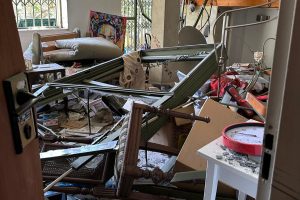Since the middle of July, several people who have entered the gallery adjacent to the lobby of Toronto’s Miles Nadal Jewish Community Centre have asked to purchase one of the pictures adorning the gallery walls.
The pictures are not for sale. They are, nevertheless, an impressive sight – and especially remarkable for a collection made by those who have only spent a few weeks learning the art of photography.
The 17 photographs currently hanging there are a part of I See: Difference in Perspective, an exhibition on display at the Miles Nadal JCC gallery until Sept. 4. The creators are young artists with disabilities.
A workshop held this spring gave these adults who live with disabilities a chance to express and empower themselves through the camera.
“This is a program that really respects the creativity of each person and… respects them as young adults,” says Liviya Mendelsohn, manager of accessibility and inclusion at the Miles Nadal JCC.
The impetus for these projects came from a need among Jewish young adults with disabilities to have outlets for expression. Accordingly, several of the artists featured in the gallery are from Toronto’s Jewish community.
This is the second year of this workshop, which has benefited from a grant from the Toronto Arts Council that allowed it to be offered for free. In 2016, photographer and accessibility activist Maayan Ziv ran the class.
This spring, the responsibility of guiding the artists was given to Steve Kean, who has spina bifida. In 2015, Kean helmed a show at Toronto’s Abbozzo Gallery that featured people with that condition posing in the nude.
“We’re all looking at life through a different lens,” Kean says, adding that he didn’t want to dictate too strictly the ways the students approached their photographs.
“I saw it as my mission to say, ‘This is your vision, this is what you want to do. Let me help you focus’.”
The workshop, which ran once a week for nine weeks, had a rhythm: one class of Kean’s theory, one class of traveling to a location in Toronto to snap pictures, one class of critiquing and editing their photographs.
The locations for these outings included Toronto’s Allan Gardens conservatory and Distillery District, as well as the Bloor West neighbourhood just a couple of blocks west of the JCC.
It is in the latter location where young artist Jacob Zavitz came across a striking image: two shoes, tied together, resting on the sidewalk.
“I kind of thought about the story behind those shoes,” Zavitz explains. “Who might have left them there, or why?”
That photograph is the only one in this exhibition that’s in black and white.
Another highlight of the gallery belongs to Max Tepper, who proudly shows off his photograph taken at the Allan Gardens. He calls the piece, Toronto Botanical Mauve, due to the lack of green and excess of mauve and yellow within the nature setting.
After I See ends, the artists will bring these large-scale photographs home.
This show is one of many recent local initiatives to explore the work of artists living with disabilities. Recently, the Tangled Art Gallery became Toronto’s first entirely accessible space for those working professionally in disability arts.
Kean tells The CJN that, despite having little teaching experience before helming the workshop, this role has changed his own artistic approach.
“These (artists), they weren’t shy to get down on the floor at Allan Gardens and try something. They weren’t afraid to experiment,” Kean says. “This was a real wake-up call for me to stay loose and try new things.”







